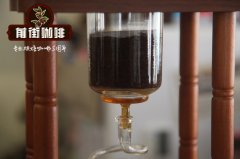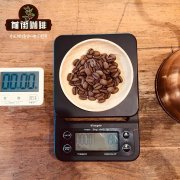The reason why there is so little fat in hand-brewed coffee why there is no oil in hand-brewed coffee.

Professional coffee knowledge exchange more coffee bean information please follow the coffee workshop (Wechat official account cafe_style)
Coffee oil vs coffee oil
Coffee beans, like other seeds such as chestnut rice and soybeans, contain oil. However, the oil on the surface of coffee beans is not the same as that on espresso. The oil on the surface of coffee beans is a water-soluble organic substance that looks like an oil, while "coffee oil" itself contains many aromatic ingredients of coffee and can be dissolved in water.
The oil content on the surface of coffee beans is generally affected by the baking method. When coffee beans are roasted deeply, they will produce oil because of their high dehydration rate, so if deep-roasted beans begin to produce oil on the surface in the first day or two of storage, it is a normal phenomenon. However, if there is oil on the light or medium culture coffee beans, it means that part of the coffee beans are over-dehydrated due to uneven heating during the roasting process, and the oil will appear in a dotted manner, which is different from the oil coming out of the whole surface of the deep-cultured coffee. If the shallow coffee beans appear the above situation, indicating that the roasting is not good, it is not recommended to continue to use.
The extraction method (such as hand-brewed coffee) affects the oil content.
About 15% to 18% of an unbaked coffee bean is coffee oil, and 80% of the oil is triglyceride (tryglyceride). Caffeine (cafestol) and white fat (Kahweol) are the main components of triglyceride in coffee and belong to saturated fat. The American Heart Association does not advise adults to take too much, or it will increase the risk of heart disease.
However, there is no need to worry too much about the health problems caused by coffee, because although coffee beans contain oil, the proportion of oil in coffee depends on the way it is extracted. Hand-brewed coffee contains the lowest coffee oil because the filter paper separates the oil. Hand-brewed coffee is more common in Southeast Asian countries, such as Japan and Taiwan, mainly because of the soft water quality (soft water) in these countries, while soft water can extract rich coffee flavor, so even if coffee oil is separated, coffee still has enough flavor.
Due to the hard water quality (Hard water) in foreign countries, it is difficult to obtain the sweetness of coffee beans, so foreigners prefer French filter pot coffee or espresso, because they can extract a stronger coffee flavor, but at the same time, these coffees contain a relatively high proportion of coffee oil. The oil of espresso is an excellent example.
Therefore, whether it is the oil on the surface of coffee beans or the oil in coffee, it will be affected by the method of baking and extraction (such as hand-brewed coffee). There is no absolute difference between good and bad. For coffee lovers, it is only one of the reference indicators. It is more important to taste different kinds of coffee and find your favorite coffee flavor.
Important Notice :
前街咖啡 FrontStreet Coffee has moved to new addredd:
FrontStreet Coffee Address: 315,Donghua East Road,GuangZhou
Tel:020 38364473
- Prev

Why is it bad to make coffee by hand? why do beginners fail to make coffee by hand?
Professional coffee knowledge exchange more coffee bean information please follow the coffee workshop (Wechat official account cafe_style) hand-brewed caffeine brewing methods and utensils are easy to use, in recent years in Europe and the United States, Japan popular. For hand-brewing coffee, you need to use a hand-brewing pot with a smaller spout to avoid insufficient extraction caused by too much water during brewing. Most of the coffee is filtered by filter paper, but it will filter out the grease and wind of coffee powder.
- Next

Is the stainless steel coffee filter easy to use? which is better than the stainless steel coffee filter or filter paper?
Professional coffee knowledge exchange more coffee bean information Please follow the coffee workshop (Wechat official account cafe_style) many hobbies buy their own coffee beans, use bean grinders, buy utensils to make coffee, will choose their own commonly used and convenient filtering methods, the following analysis and comparison, filter paper, coffee filter, filter cloth, these utensils are not only convenient but also easy to use. Paper coffee filter paper coffee filter
Related
- Beginners will see the "Coffee pull flower" guide!
- What is the difference between ice blog purified milk and ordinary milk coffee?
- Why is the Philippines the largest producer of crops in Liberia?
- For coffee extraction, should the fine powder be retained?
- How does extracted espresso fill pressed powder? How much strength does it take to press the powder?
- How to make jasmine cold extract coffee? Is the jasmine + latte good?
- Will this little toy really make the coffee taste better? How does Lily Drip affect coffee extraction?
- Will the action of slapping the filter cup also affect coffee extraction?
- What's the difference between powder-to-water ratio and powder-to-liquid ratio?
- What is the Ethiopian local species? What does it have to do with Heirloom native species?

